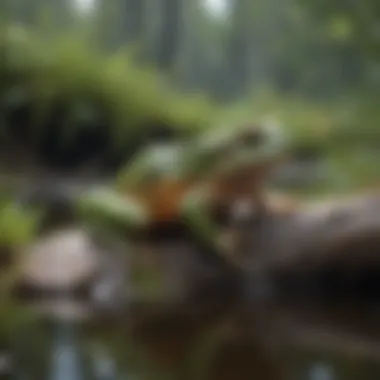Exploring Wetland Animals: Ecology and Adaptations


Intro
Wetlands are often overlooked ecosystems that play a vital role in maintaining ecological balance. They serve as a bridge between land and water, hosting diverse species of flora and fauna. The animals that inhabit these areas have developed unique adaptations to thrive in fluctuating water levels and variable nutrient availability.
This article aims to explore the significance of wetland animals, their ecological contributions, and the urgent need for habitat preservation. Wetland ecosystems are under threat from human activity and climate change, making understanding these animals essential for future conservation efforts.
Research Overview
Wetlands encompass a variety of environments, including swamps, marshes, and bogs. This section outlines the key findings regarding the adaptations and roles of wetland animals, along with the research objectives guiding the exploration of this topic.
Summary of Key Findings
Research highlights that wetland animals exhibit distinct characteristics such as specialized breathing mechanisms in amphibians and unique camouflage strategies in avian species. These adaptations enable them to survive in challenging conditions. The role of wetland animals extends beyond their survival; they contribute to nutrient cycling and water purification, greatly benefitting the ecosystem.
Research Objectives and Hypotheses
The primary objectives of this research include:
- To examine the specific adaptations of key wetland species.
- To understand their ecological roles within their habitat.
- To assess the impact of environmental changes on these species.
A hypothesis posited is that greater biodiversity within wetland habitats leads to improved ecosystem functionality.
Methodology
To unravel the complexities of wetland animals, a multi-faceted research approach was employed. The methodology included field studies and literature reviews to ensure comprehensive data gathering.
Study Design and Approach
The study design encompassed both observational and experimental components, focusing on animal behavior, diet, and interactions among species. Field surveys provided direct insights into the animal populations while lab experiments tested specific hypotheses about their adaptations.
Data Collection Techniques
Data was collected using various techniques:
- Field Sampling: Identifying and recording species in diverse wetland types.
- Camera Traps: Observing nocturnal behavior without human presence.
- Interviews with Local Ecologists: Gaining insights on changes observed in wetland ecosystems over time.
"Wetland animals are not just residents of these ecosystems; they are crucial actors in the maintenance and health of these environments."
Through this structured approach, the research aims to provide a clearer understanding of wetland animal ecology, their adaptations, and the pressing need for conservation efforts.
Understanding Wetlands
Wetlands are vital ecosystems that play a crucial role in supporting biodiversity, maintaining environmental health, and regulating water cycles. This section aims to provide a basic foundation for understanding wetlands and their significance within the broader ecological context.
Definition and Types of Wetlands
Wetlands are defined as areas where water covers the soil, either permanently or seasonally, creating unique habitats for diverse flora and fauna. These areas can be classified into various types based on their characteristics and water sources. Some common types include:
- Marshes: Typically dominated by herbaceous plants, marshes are found in both freshwater and saltwater regions.
- Swamps: Characterized by the presence of woody plants and trees, swamps are often more biologically diverse than marshes.
- Bogs: These are acidic wetlands, rich in sphagnum moss, and generally low in nutrients.
- Fens: Similar to bogs, but with more nutrient availability and influenced by groundwater.
This classification helps in understanding the habitat needs of various wetland species.
Importance of Wetlands in the Ecosystem
Wetlands serve numerous functions in the environment. They act as natural water filters, trapping pollutants and sediments before they enter larger water bodies. This filtering process is essential for maintaining water quality. Wetlands also offer flood protection by absorbing excess rainfall and reducing runoff. Moreover, they are crucial for biodiversity, harboring nearly 40% of the world’s species while covering only a small percentage of the Earth's surface. The ecological significance of wetlands is profound, directly impacting nutrient cycling, carbon storage, and habitat provision.
"Wetlands are among the most productive ecosystems in the world, contributing to the health of our planet's water systems and biodiversity."
Geographic Distribution of Wetlands
Understanding the geographic distribution of wetlands is vital for conservation efforts. Wetlands can be found on every continent, though their extent and type vary significantly. Major wetland regions include:
- The Everglades in Florida, USA, which is a unique subtropical wetland.
- The Pantanal in South America, known as one of the world’s largest tropical wetland areas.
- The Sundarbans in India and Bangladesh, which is a vast mangrove forest.
- The Okavango Delta in Botswana, a major inland delta that supports diverse wildlife.


Despite their global presence, wetlands face threats such as urbanization and climate change. Understanding where these ecosystems exist is essential for targeted conservation strategies.
Biodiversity of Wetland Animals
Wetlands are essential environments teeming with life. Their high biodiversity reflects the diverse ecological niches wetlands provide. The importance of these habitats cannot be overstated, as they support a wide array of animal species, each adapted to exploit the specific resources available. Biodiversity in wetland animals contributes to the overall resilience of these ecosystems, helping them to recover from disturbances and maintain functionality.
Wetland animals include various invertebrates, fish, amphibians, reptiles, birds, and mammals. Each plays a unique role in the ecosystem, creating complex interactions that sustain the biological community. Understanding this biodiversity is critical for conservation efforts and ecosystem management. Recognizing the key species that inhabit wetlands also helps identify the health of the ecosystem and the potential impacts of environmental changes.
Key Species of Wetland Animals
Wetlands host a variety of key species that can serve as indicators of ecosystem health. For instance, creatures such as the American alligator, great blue heron, and red-winged blackbird are quintessential to these habitats.
- American Alligator: As a top predator, this reptile plays a crucial role in regulating fish populations and maintaining healthy aquatic communities.
- Great Blue Heron: This bird is adept at fishing and serves as an indicator of local fish populations and water quality.
- Red-winged Blackbird: A common sight in many wetlands, this bird helps control insect populations and is vital for seed dispersal.
These species illustrate the diversity found in wetlands. Their presence often indicates a healthy ecosystem.
Invertebrates: The Unsung Heroes of Wetlands
Invertebrates are often overlooked in discussions about wetland biodiversity, but they are critical to these ecosystems. They include a multitude of species, such as insects, crustaceans, and mollusks. These organisms are essential in the food web, serving as prey for larger animals. Invertebrates also play a key role in detritus breakdown and nutrient cycling, maintaining water quality.
Key examples of wetland invertebrates:
- Dragonflies and Damselflies: Their larvae live underwater and are efficient predators of mosquito larvae.
- Caddisflies: Their presence indicates clean water and they contribute to the food supply for fish and birds.
- Snails: They are important grazers on algae and contribute to the nutrient balance in wetland waters.
Fish Species Found in Wetlands
Wetlands are vital spawning and nursery grounds for several fish species. They provide shelter and abundant food sources. Fish like the brook trout, yellow perch, and various species of catfish thrive in these environments.
The health of fish populations in wetlands is indicative of the overall health of the ecosystem. For example, the decline of certain fish species may signal a problem with water quality or habitat degradation.
Amphibians and Reptiles: Adaptations and Habits
Amphibians and reptiles demonstrate fascinating adaptations for survival. Frogs, salamanders, turtles, and snakes all have specialized traits that help them thrive in wetland habitats.
- Frogs are known for their permeable skins, allowing gas exchange and moisture absorption.
- Salamanders often rely on moist environments to prevent desiccation, while they also hunt for small invertebrates.
- Turtles tend to have aquatic adaptations, like webbed feet and the ability to hold their breath for extended periods.
These adaptations allow amphibians and reptiles to exploit various niches within wetland ecosystems.
Birds of the Wetlands: Nesting and Feeding Strategies
Birds in wetland areas have developed unique nesting and feeding strategies. The availability of water and diverse plant life supports many species.
- Nesting: Many birds such as the American bittern choose locations that provide concealment. They often build nests in dense vegetation to protect their young.
- Feeding: Species like the mallard duck feed on aquatic plants and invertebrates, while others hunt for fish or insects. This diversity in feeding habits underscores the wetlands' role as a critical habitat for avian species.
Mammals in the Wetlands: Roles and Interactions
Mammals in wetlands, such as beavers, otters, and muskrats, play important roles in these ecosystems.
- Beavers are known as ecosystem engineers. Their dam-building behavior creates ponds that provide habitats for various organisms.
- Otters serve as indicators of a healthy ecosystem, often relying on abundant fish populations.
- Muskrats contribute to nutrient cycling by feeding on aquatic vegetation and their burrowing activities enhance habitat complexity.
The interactions between these mammals and their environment highlight the interconnectedness of wetland ecosystems.
In summary, the biodiversity of wetland animals holds immense value. By recognizing and understanding the key species and their roles, we gain insights into the overall health and significance of these ecosystems.
"The health of wetlands is a reflection of the treatment of their ecosystems; preserving this biodiversity is critical for the survival of many species and the balance of nature."
Adaptations of Wetland Animals
The adaptations of wetland animals are critical for their survival in these unique ecosystems. Wetlands are diverse environments that include marshes, swamps, and bogs. The animals that inhabit these areas have evolved, allowing them to thrive while facing distinct challenges. Understanding these adaptations sheds light on the function of wetland species within the broader ecosystem.
Physiological Adaptations to Aquatic Environments
Wetland animals exhibit a variety of physiological adaptations to manage life in water-saturated habitats. For instance, many amphibians, such as frogs, have permeable skin, allowing for the absorption of moisture and gases while regulating body temperature.


Fish species, such as the catfish, possess specialized gills to extract oxygen from water efficiently. This adaptation is essential due to often fluctuating oxygen levels in wetlands.
Additionally, some reptiles, like turtles, develop permeable shells that enable them to absorb water while submerged. Such physiological characteristics are vital for osmoregulation, which is the maintenance of water balance in the body. The ability to thrive in aquatic environments directly correlates to the diverse survival strategies necessary for wetland life.
Behavioral Strategies for Survival
Behavioral adaptations also play a central role in the survival of wetland animals. Many species have developed specific behaviors to cope with both predation and environmental threats. For example, some birds, like the American bittern, rely on camouflage to avoid detection while hunting.
Migration is another critical behavioral adaptation. Many wetland birds, including cranes and ducks, migrate to avoid harsh winter conditions. This seasonal movement allows them to access abundant resources in warmer climates.
Furthermore, social behaviors, such as flocking in birds, can reduce the risk of predation and enhance foraging efficiency. These adaptive behaviors highlight the dynamic nature of survival strategies employed by wetland animals.
Reproductive Adaptations in Wetland Animals
The reproductive adaptations of wetland animals are equally vital for ensuring species continuity. Wetland environments often present challenges like fluctuating water levels and varying food availability. Many amphibians, such as salamanders, choose to breed during specific times of the year when conditions are most favorable.
Some fish species, like the bluegill sunfish, demonstrate unique nesting behaviors that increase the likelihood of offspring survival. Males may create nests or guard territories, attracting females who search for secure spawning areas.
Moreover, parental care in several mammal species, for instance, beavers, plays an essential role in nurturing young until they are capable of independent survival. These reproductive strategies illustrate how wetland animals adapt their breeding habits to maximize species survival in challenging environments.
The Role of Wetland Animals in Ecosystem Dynamics
Wetland animals play a crucial role in maintaining the health and stability of their ecosystems. Their interactions within the wetland environment impact various biogeochemical processes, thus influencing not only their habitats but also surrounding terrestrial environments. Understanding these dynamics is essential for conservation efforts and sustainable management of wetlands.
Food Webs and Interactions
The food web in wetland ecosystems is intricate and highlights the interconnectedness of various species. Wetland animals occupy multiple trophic levels, contributing to the flow of energy and nutrients.
- Primary producers, such as aquatic plants, form the base of the food web.
- Herbivores, including certain invertebrates and fish, graze on these plants.
- Predator species, such as frogs, birds, and larger fish, feed on the herbivores, creating a balanced interaction.
This dynamic not only supports the population of various species but also regulates their numbers, preventing any one species from dominating the ecosystem. The removal or decline of any species within the web could disrupt these interactions, leading to ecological imbalances.
Pollination and Seed Dispersal
Wetland habitats are often home to diverse plant species that require pollination and seed dispersal for reproduction. Animals such as bees, insects, and some birds play a significant role in these processes. For instance:
- Insects frequently pollinate wetland flowers, aiding in genetic diversity and plant productivity.
- Certain bird species consume fruits and later disperse seeds, promoting the growth of vegetation in new areas.
This mutualistic relationship between animals and plants enhances biodiversity, contributing to a resilient ecosystem. Healthy plant populations also provide shelter and food for various wetland animals, further solidifying these ecological interactions.
Water Quality Regulation and Nutrient Cycling
Wetland animals are instrumental in regulating water quality and cycling nutrients. Their activities contribute to the purification of water and the recycling of organic materials. Some key points include:
- Detritivores, like earthworms and certain beetles, break down organic matter, which enriches the soil and improves nutrient availability for plants.
- Fish and invertebrates help to control algae growth by consuming it, thereby maintaining clear water for photosynthesis.
- The behavioral patterns of amphibians and other species can influence habitat structure, leading to better water retention and filtration.
"Wetlands act as natural filters, and the role of animals is critical in maintaining this essential function."
Through these processes, wetland animals not only sustain their environment but also ensure the health of adjacent ecosystems. Recognizing and preserving these relationships is vital for conserving wetland biodiversity and functionality.
Threats to Wetland Animals
Wetland animals face significant threats stemming from various human activities and environmental changes. Understanding these threats is crucial not only for the survival of these species but also for the overall health of wetland ecosystems. Wetlands are among the most productive ecosystems on Earth, providing essential services such as water filtration, flood protection, and habitat for biodiversity. The threats to wetland animals can lead to declines in population, loss of species, and disruption of ecological balance.
Habitat Loss and Degradation
Habitat loss is one of the most pressing threats to wetland animals. Urban development, agriculture, and industrial activities often encroach upon wetland areas, leading to their destruction. When wetlands are drained or filled, many species lose their homes. This loss impacts not only the animals directly residing in these habitats but also the interconnected species that rely on them for food and survival.
Moreover, the degradation of wetland quality due to invasive species or altered water regimes can significantly affect local fauna. Wetlands need specific conditions to thrive. Changes in water levels, sedimentation, and nutrient loading can create unfavourable habitats for wetland animals. This can lead to a decline in diversity and abundance of species such as amphibians, fish, and birds.
Pollution and Its Impact on Wildlife
Pollution poses a substantial threat to wetland animals, disrupting aquatic ecosystems. Industrial runoff, agricultural pesticides, and sewage discharge introduce various pollutants into wetlands. These toxins can accumulate in the food web, affecting not only the health of individual species but also the overall ecological integrity of wetland environments.


For example, high levels of nutrients from fertilizers can lead to eutrophication, which decreases oxygen levels in water. This affects fish and invertebrates, leading to dead zones where life cannot be sustained. Thus, pollution undermines the habitats that wetland animals depend on for feeding, breeding, and shelter.
Climate Change Challenges
Climate change is creating new challenges for wetland animals. Rising temperatures, shifting precipitation patterns, and sea-level rise alter the dynamics of these ecosystems. Many wetland species have specific habitat requirements tied closely to their environment. Changes in temperature can impact breeding cycles, seasonal behaviors, and food availability. Furthermore, the increased frequency of extreme weather events can lead to more intense flooding or droughts, which can disrupt the balance of these fragile ecosystems.
Wetlands also act as buffers for climate change by storing carbon. The degradation of these ecosystems not only affects the species residing in them but also exacerbates climate change by releasing stored carbon into the atmosphere. Therefore, addressing climate change is vital for the conservation of wetland habitats and the animals that live within them.
"Wetland conservation is crucial not just to protect wildlife, but also to ensure ecosystem resilience against climate change."
In summary, threats to wetland animals are multifaceted, involving habitat loss, pollution, and climate change. There is a clear need for effective conservation strategies that address these challenges head-on. Understanding the impacts on wetland animals will not just assist in species preservation but also in maintaining the overall health and functionality of wetland ecosystems.
Conservation Efforts for Wetland Animals
Conservation efforts for wetland animals are critical for maintaining the ecological balance of these unique ecosystems. Wetlands provide habitat for many species, but they are threatened by several factors. Effective conservation strategies are necessary to protect both the habitats and the animals that depend on them. Various initiatives focus on the preservation of wetlands, ensuring that diverse species can thrive. This section will discuss significant aspects of conservation efforts, their benefits, and key considerations in their implementation.
Protected Areas and Reserves
Establishing protected areas and reserves is one of the most effective ways to conserve wetland habitats. These areas serve as shields against development, pollution, and other environmental threats. Protected status ensures that the region remains intact and undisturbed by human activity. Not only do these areas safeguard the physical environment, but they also offer a refuge for wildlife.
Such reserves often come with regulations that restrict harmful activities. For example, controlling fishing or hunting practices helps maintain species populations. Areas like the Everglades National Park in Florida serve as prime examples of how protected areas can benefit wetland animals. This park is home to diverse species and promotes biodiversity, highlighting the value of conservation zones.
Additionally, protecting larger landscapes that connect separate wetlands can create viable corridors for animals. These connections encourage gene flow and resilience in populations.
Restoration Projects and Their Effectiveness
Wetland restoration has gained prominence as a vital component of conservation. Restoring degraded wetlands can reinstate habitats and improve ecosystem health. Projects often involve removing invasive species, reestablishing native vegetation, and restoring hydrology.
For instance, the Wetlands Restoration Program in California aims to restore over 100,000 acres of wetlands by addressing past mismanagement. Early results show improved water quality and increased biodiversity.
However, the effectiveness of restoration initiatives can vary. Success typically depends on factors like the initial conditions of the site and the techniques used in restoration. Continuous monitoring is necessary to assess how well these projects achieve their goals, as well as to adapt strategies as needed.
Community Involvement and Education
Community involvement plays a pivotal role in conservation efforts. Engaging local communities raises awareness about the significance of wetlands. People are more likely to protect what they understand and feel connected to. Educational programs about wetland ecology can instill a sense of responsibility towards these fragile ecosystems.
Volunteer initiatives, like clean-up days or citizen science projects, also effectively engage communities. When individuals participate actively in preservation activities, they become advocates for conservation. Projects should focus on fostering this engagement, creating lasting change.
"Making conservation a community focus can lead to more sustainable practices and greater respect for local ecosystems."
Ultimately, bridging the gap between scientific knowledge and community action is essential for successful conservation. Collaboration among experts, policymakers, and citizens can drive significant progress in preserving wetland habitats and the associated wildlife.
In summary, effective conservation efforts for wetland animals hinge on protected areas, restoration projects, and community involvement. Prioritizing these elements can help mitigate the threats that wetlands face, ensuring a healthier ecosystem for future generations.
Future of Wetland Animals
The future of wetland animals is critical to understanding the challenges these species face and the strategies for their preservation. As wetland ecosystems undergo various pressures, the resilience of both the habitats and their inhabitants depends on informed actions and innovative research. Recognizing the significance of conserving these unique environments is not just about saving animals; it is also about maintaining biodiversity, ecological health, and the services wetlands provide to society.
Research Directions and Innovations
Research plays a pivotal role in shaping conservation efforts for wetland animals. New technologies such as remote sensing and genetic analysis are opening doors for smarter conservation strategies. Utilizing drones, scientists can survey vast wetlands quickly and gather data on animal populations and habitat conditions. Furthermore, Citizen Science is gaining momentum, as the public gets involved in data collection and monitoring. This participatory approach expands the reach of research while increasing public investment in conservation efforts.
Moreover, developments in ecological modeling allow researchers to predict how wetland creatures might respond to environmental changes. By understanding these patterns, conservationists can create more effective management plans that anticipate future challenges.
Importance of Public Awareness and Policy Changes
Public awareness is essential for effective conservation of wetland animals. The more informed the public is about the value of wetland ecosystems, the more likely they are to support policies that protect them. Campaigns that focus on the ecological services provided by wetlands, such as flood mitigation and water purification, can enhance community understanding. Social media platforms such as Facebook and Reddit facilitate discussion and education about wetland conservation, making it easier for conservationists to reach wider audiences.
Increased public pressure can lead to robust policy changes. Local, regional, and global policies that favor sustainable practices can create a safer and healthier environment for wetland animals. Collaboration between governments, non-profits, and local communities must be a priority to create effective legislation that accounts for biodiversity needs.
Global Perspectives on Wetland Conservation
Globally, the perspectives on wetland conservation vary significantly based on socio-economic conditions and cultural values. Some regions prioritize development over conservation, leading to wetland degradation. In contrast, other areas have recognized the ecological and economic benefits of preserving these environments.
International agreements, such as the Ramsar Convention, aim to promote the sustainable use of wetlands worldwide. By fostering cooperation between nations, these frameworks encourage the sharing of good practices and resources.
It is essential for all countries to acknowledge that wetland conservation is not just a local issue; it is a global necessity. Supporting scientific research and fostering international dialogue about best practices can contribute significantly to the future well-being of wetland animals.
"Protecting wetland habitats is vital, not only for the myriad species that inhabit them but also for the health of the planet overall."















